1. Russell MB, Rasmussen BK, Thorvaldsen P, Olesen J. Prevalence and sex-ratio of the subtypes of migraine. Int J Epidemiol. 1995; 24(3):612–618. PMID:
7672904.
2. Viana M, Sances G, Linde M, Ghiotto N, Guaschino E, Allena M, et al. Clinical features of migraine aura: results from a prospective diary-aided study. Cephalalgia. 2017; 37(10):979–989. PMID:
27573009.
3. Jo N, Kim BK. Clinical characteristics of migraine with Aura in Korean: a clinic based study. J Korean Neurol Assoc. 2015; 33(4):278–281.
4. Viana M, Tronvik EA, Do TP, Zecca C, Hougaard A. Clinical features of visual migraine aura: a systematic review. J Headache Pain. 2019; 20(1):64. PMID:
31146673.
5. Matharu MJ, Goadsby PJ. Post-traumatic chronic paroxysmal hemicrania (CPH) with aura. Neurology. 2001; 56(2):273–275. PMID:
11160973.
6. Peres MF, Siow HC, Rozen TD. Hemicrania continua with aura. Cephalalgia. 2002; 22(3):246–248. PMID:
12047466.
7. Silberstein SD, Niknam R, Rozen TD, Young WB. Cluster headache with aura. Neurology. 2000; 54(1):219–221. PMID:
10636152.
8. Bolay H, Vuralli D, Goadsby PJ. Aura and Head pain: relationship and gaps in the translational models. J Headache Pain. 2019; 20(1):94. PMID:
31481015.
9. Hautakangas H, Winsvold BS, Ruotsalainen SE, Bjornsdottir G, Harder AV, Kogelman LJ, et al. Genome-wide analysis of 102,084 migraine cases identifies 123 risk loci and subtype-specific risk alleles. Nat Genet. 2022; 54(2):152–160. PMID:
35115687.
10. Eriksen MK, Thomsen LL, Olesen J. The Visual Aura Rating Scale (VARS) for migraine aura diagnosis. Cephalalgia. 2005; 25(10):801–810. PMID:
16162257.
11. Kim BK, Cho S, Kim HY, Chu MK. Validity and reliability of the self-administered Visual Aura Rating Scale questionnaire for migraine with aura diagnosis: a prospective clinic-based study. Headache. 2021; 61(6):863–871. PMID:
34106459.
12. Kim KM, Kim BK, Lee W, Hwang H, Heo K, Chu MK. Prevalence and impact of visual aura in migraine and probable migraine: a population study. Sci Rep. 2022; 12(1):426. PMID:
35013446.
14. Headache Classification Committee of the International Headache Society (IHS) The International Classification of Headache Disorders, 3rd edition. Cephalalgia. 2018; 38(1):1–211.
15. Kim BK, Cho SJ, Kim BS, Sohn JH, Kim SK, Cha MJ, et al. Comprehensive application of the International Classification of Headache Disorders third edition, beta version. J Korean Med Sci. 2016; 31(1):106–113. PMID:
26770045.
16. Kim KM, Kim AR, Lee W, Jang BH, Heo K, Chu MK. Development and validation of a web-based headache diagnosis questionnaire. Sci Rep. 2022; 12(1):7032. PMID:
35488015.
17. Chen WT, Hsiao FJ, Ko YC, Liu HY, Wang PN, Fuh JL, et al. Comparison of somatosensory cortex excitability between migraine and “strict-criteria” tension-type headache: a magnetoencephalographic study. Pain. 2018; 159(4):793–803. PMID:
29319611.
18. Stewart WF, Lipton RB, Whyte J, Dowson A, Kolodner K, Liberman JN, et al. An international study to assess reliability of the Migraine Disability Assessment (MIDAS) score. Neurology. 1999; 53(5):988–994. PMID:
10496257.
19. Lee HS, Chung CS, Song HJ, Park HS. The reliability and validity of the MIDAS (Migraine Disability Assessment) Questionnaire for Korean migraine sufferers. J Korean Neurol Assoc. 2000; 18(3):287–291.
20. Wolfe F, Clauw DJ, Fitzcharles MA, Goldenberg DL, Häuser W, Katz RL, et al. 2016 Revisions to the 2010/2011 fibromyalgia diagnostic criteria. Semin Arthritis Rheum. 2016; 46(3):319–329. PMID:
27916278.
21. Jakubowski M, Silberstein S, Ashkenazi A, Burstein R. Can allodynic migraine patients be identified interictally using a questionnaire? Neurology. 2005; 65(9):1419–1422. PMID:
16275830.
22. Lipton RB, Bigal ME, Ashina S, Burstein R, Silberstein S, Reed ML, et al. Cutaneous allodynia in the migraine population. Ann Neurol. 2008; 63(2):148–158. PMID:
18059010.
23. Breslau N, Lipton RB, Stewart WF, Schultz LR, Welch KM. Comorbidity of migraine and depression: investigating potential etiology and prognosis. Neurology. 2003; 60(8):1308–1312. PMID:
12707434.
24. Kroenke K, Spitzer RL, Williams JB, Monahan PO, Löwe B. Anxiety disorders in primary care: prevalence, impairment, comorbidity, and detection. Ann Intern Med. 2007; 146(5):317–325. PMID:
17339617.
25. Wacogne C, Lacoste JP, Guillibert E, Hugues FC, Le Jeunne C. Stress, anxiety, depression and migraine. Cephalalgia. 2003; 23(6):451–455. PMID:
12807524.
26. Seo JG, Kim BK, Chu MK, Cho SJ, Chung PW, Moon HS, et al. Suicidality and its risk factor in migraine patients. J Korean Neurol Assoc. 2022; 40(3):228–234.
27. Kroenke K, Spitzer RL, Williams JB. The PHQ-9: validity of a brief depression severity measure. J Gen Intern Med. 2001; 16(9):606–613. PMID:
11556941.
28. Spitzer RL, Kroenke K, Williams JB, Löwe B. A brief measure for assessing generalized anxiety disorder: the GAD-7. Arch Intern Med. 2006; 166(10):1092–1097. PMID:
16717171.
29. Frank SH, Zyzanski SJ. Stress in the clinical setting: the Brief Encounter Psychosocial Instrument. J Fam Pract. 1988; 26(5):533–539. PMID:
3367118.
30. Park SJ, Choi HR, Choi JH, Kim KW, Hong JP. Reliability and Validity of the Korean Version of the Patient Health Questionnaire-9 (PHQ-9). Anxiety Mood. 2010; 6(2):119–124.
31. Seo JG, Park SP. Validation of the Generalized Anxiety Disorder-7 (GAD-7) and GAD-2 in patients with migraine. J Headache Pain. 2015; 16(1):97. PMID:
26596588.
32. Yim J, Bae J, Choi S, Kim S, Hwang H, Huh B. The validity of modified Korean-translated BEPSI (Brief Encounter Psychosocial Instrument) as instrument of stress measurement in outpatient clinic. J Korean Acad Fam Med. 1996; 17(1):42–53.
33. Olejnik SF, Algina J. Parametric ANCOVA and the rank transform ANCOVA when the data are conditionally non-normal and heteroscedastic. J Educ Stat. 1984; 9(2):129–149.
34. Cao Y, Welch KM, Aurora S, Vikingstad EM. Functional MRI-BOLD of visually triggered headache in patients with migraine. Arch Neurol. 1999; 56(5):548–554. PMID:
10328249.
35. Hadjikhani N, Sanchez Del Rio M, Wu O, Schwartz D, Bakker D, Fischl B, et al. Mechanisms of migraine aura revealed by functional MRI in human visual cortex. Proc Natl Acad Sci U S A. 2001; 98(8):4687–4692. PMID:
11287655.
36. Welch KM, Barkley GL, Ramadan NM, D’Andrea G. NMR spectroscopic and magnetoencephalographic studies in migraine with aura: support for the spreading depression hypothesis. Pathol Biol (Paris). 1992; 40(4):349–354. PMID:
1495820.
37. Charles AC, Baca SM. Cortical spreading depression and migraine. Nat Rev Neurol. 2013; 9(11):637–644. PMID:
24042483.
38. Seo W, Lee JB, Koh SB, Kim BJ, Park MK, Park KW, et al. Headache Epidemiologic Study in Ansan City, Kyunggi-Do, Korea. J Korean Neurol Assoc. 2002; 20(5):479–485.
39. Zhang Y, Shi Z, Hock D, Yue W, Liu S, Zhang Y, et al. Prevalence of primary headache disorders in a population aged 60 years and older in a rural area of Northern China. J Headache Pain. 2016; 17(1):83. PMID:
27619363.
40. Hagen K, Stovner LJ, Zwart JA. Time trends of major headache diagnoses and predictive factors. Data from three Nord-Trøndelag health surveys. J Headache Pain. 2020; 21(1):24. PMID:
32160857.

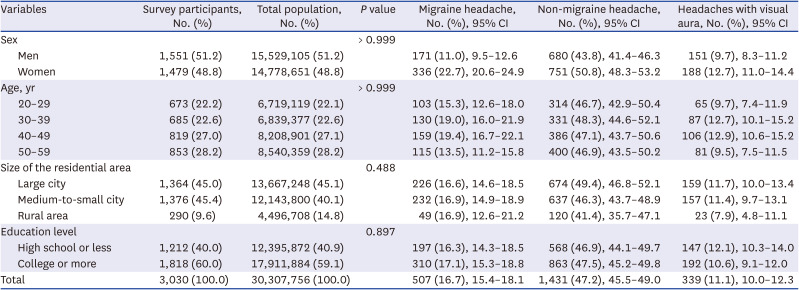
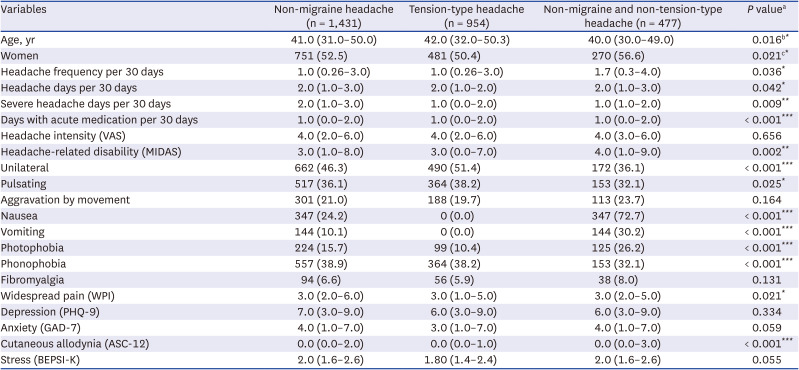

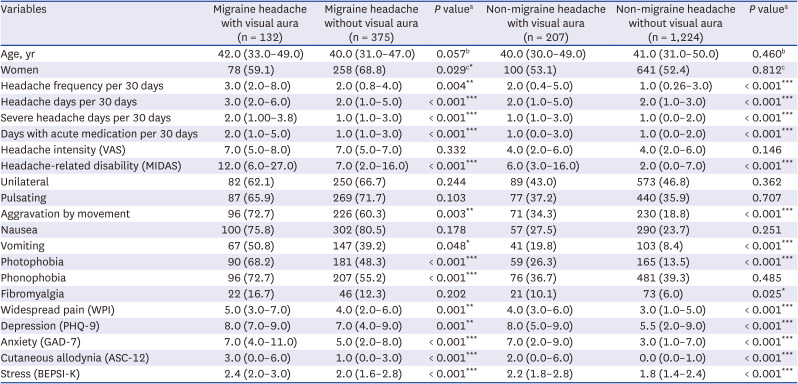
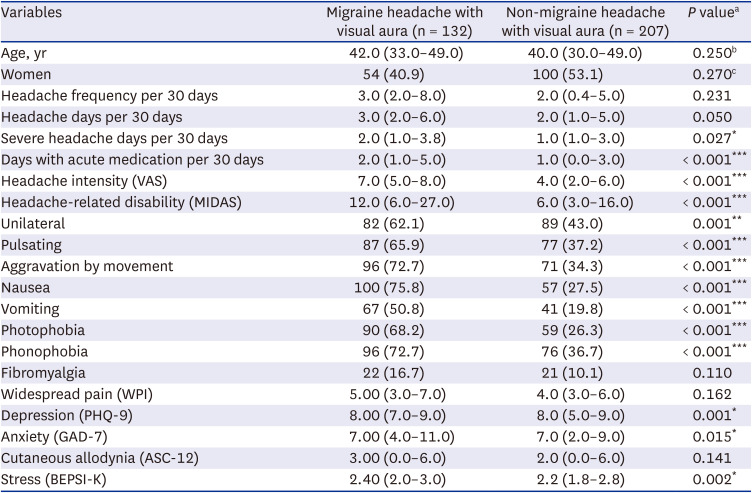




 PDF
PDF Citation
Citation Print
Print



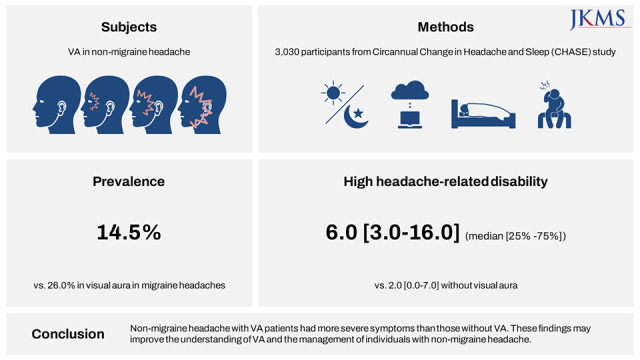
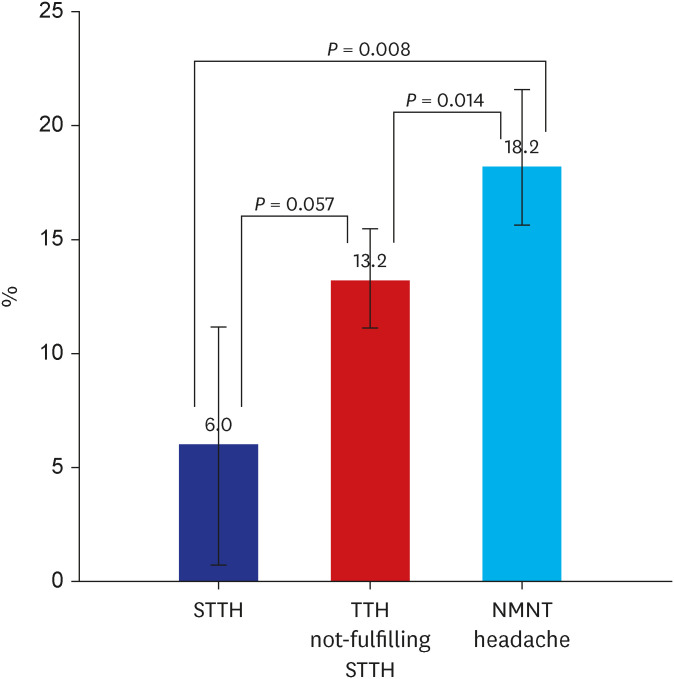

 XML Download
XML Download